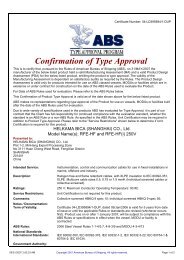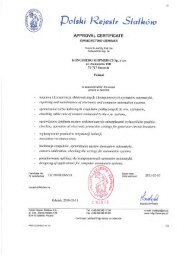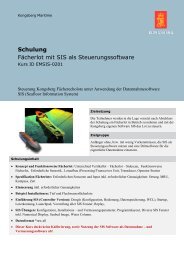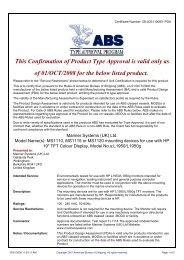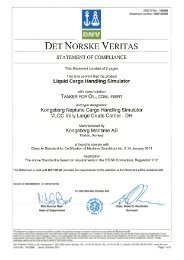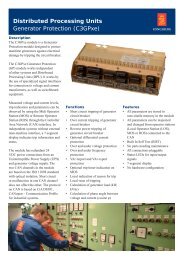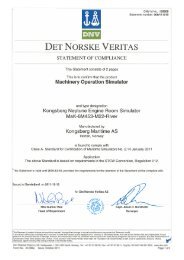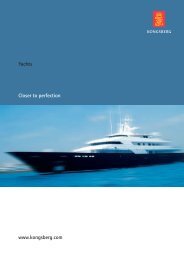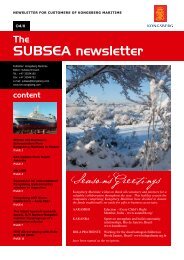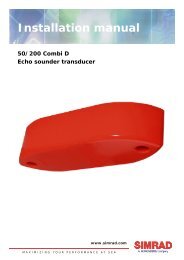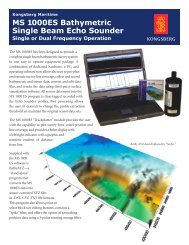No. 3 - August 2005 - Kongsberg Maritime
No. 3 - August 2005 - Kongsberg Maritime
No. 3 - August 2005 - Kongsberg Maritime
You also want an ePaper? Increase the reach of your titles
YUMPU automatically turns print PDFs into web optimized ePapers that Google loves.
NEWSLETTER FOR CUSTOMERS OF KONGSBERG MARITIME<br />
03/05<br />
The<br />
SUBSEA newsletter<br />
Publisher: <strong>Kongsberg</strong> <strong>Maritime</strong><br />
Editor: Subsea Division<br />
Tel.: +47 33034100<br />
Fax: +47 33034384<br />
e-mail: subsea@kongsberg.com<br />
www.km.kongsberg.com<br />
content<br />
The ‘Priz AS–28’ Russian<br />
submarine crew safely rescued<br />
PAGE 2<br />
EM 710 Multibeam system<br />
for “Matthew” of CHS<br />
PAGE 3<br />
EGS International purchases<br />
dual head EM 3002D<br />
PAGE 4<br />
Additional multibeam capability<br />
for the UK Royal Navy<br />
PAGE 5<br />
New Upgrade and Maintenance<br />
Contract with US Navy<br />
PAGE 6<br />
Operation Support US<br />
PAGE 7<br />
Training for the future<br />
PAGE 8<br />
First field results for the new <strong>Kongsberg</strong><br />
HISAS Synthetic Aperture Sonar<br />
Synthetic aperture sonars combine a<br />
number of acoustic pings to form an<br />
image with much higher resolution than<br />
conventional sonars, typically 10 times<br />
higher.<br />
The HISAS sonar is part of the HUGIN<br />
system solution for mine countermeasures,<br />
which has been ordered<br />
recently by the <strong>No</strong>rwegian Navy. HISAS<br />
is a wideband SAS sonar with frequency<br />
range of 70-100kHz, capable of producing<br />
ultra high resolution acoustic images as<br />
well as co-registered bathymetry. The<br />
sonar is tightly integrated with the INS<br />
navigation and motion sensing platform<br />
of the HUGIN AUV, and makes use of<br />
modern signal processing such as DPCA<br />
(Displaced Phase Centre Analysis) to<br />
process the raw data into images.<br />
The sonar prototype has recently been<br />
tested with success at sea outside Horten,<br />
with signal processing done by FFI. The<br />
image above is from this test and shows<br />
a sunken wreck standing upright on the<br />
bottom. It has a resolution of about 4 cm<br />
both along track and across, each acoustic<br />
beam being processed from 40 consecutive<br />
pings. If the reproduction of the image<br />
is good, one can observe details such as<br />
the wire running from the bow to the top<br />
of the mast.
THE SUBSEA NEWSLETTER PAGE 2<br />
AUGUST <strong>2005</strong><br />
The ‘Priz AS–28’ Russian submarine crew safely rescued<br />
rine from surfacing. When the final<br />
net was cut, the ROV was recovered<br />
and the Priz AS-28 immediately blew<br />
its tanks surfacing three minutes later.<br />
The crew opened the hatch themselves<br />
and climbed out unaided from the submarine.<br />
Royal Navy Commander Ian Riches<br />
praised his ROV operators, and thanked<br />
the Royal Air Force for delivering the<br />
ROV and its crew, and all the contractors<br />
involved with the UK Submarine<br />
Rescue Service who make this international<br />
capability a reality.<br />
In response to a call for assistance a<br />
Royal Navy Submarine Rescue Service<br />
Remotely Operated Vehicle (ROV)<br />
arrived in Petropavlovsk-Kamchatsky,<br />
off Russias far eastern Kamchatka<br />
pennisula, on Sunday 7th <strong>August</strong> <strong>2005</strong>.<br />
Its task was to assist in the rescue of the<br />
Priz AS-28 submarine and its crew of<br />
seven Russian submariners trapped 625<br />
feet down on the icy Pacific Ocean floor,<br />
with a rapidly diminishing air supply.<br />
The ROV, fitted with <strong>Kongsberg</strong> <strong>Maritime</strong><br />
cameras and transponders, spent<br />
five hours cutting away at the fishing<br />
net cables that prevented the subma-<br />
Fugro in unprecedented detail<br />
Fugro Survey Ltd and AOA Geophysics<br />
Inc have mapped the Cap de Creus<br />
canyon head, northeast of Barcelona,<br />
acquiring a data set that demonstrates<br />
Fugro and AOAs extensive capabilities<br />
with hull-mounted multibeam systems.<br />
The map data clearly shows a wide range<br />
of active geologic processes, from mass<br />
wasting and furrows, to faults and seafloor<br />
seepage, in unprecedented detail.<br />
The Cap de Creus canyon head is the<br />
subject of an ongoing Euro STRATA-<br />
FORM study supported by the European<br />
Community and the US Office of Naval<br />
Research. Dr Tom Drake, team leader<br />
for the Office of Naval Researchs Coastal<br />
Geosciences Program, said, “I am<br />
more than pleased with the preliminary<br />
data Ive seen so far and totally amazed<br />
that you were able to get all the necessary<br />
logistics lined up in a very short<br />
time. <strong>No</strong>thing beats real professionals<br />
for getting the job done.” The data were<br />
acquired with a hull-mounted <strong>Kongsberg</strong><br />
EM 300 30kHz system (1x1 degree configuration)<br />
on Fugros Geo Prospector.<br />
<strong>No</strong>rthwest-southeast lines were run approximately<br />
parallel to the canyon axis,<br />
at speeds varying from 6.5 to 8 knots.<br />
The beam configuration was controlled<br />
Mike Topp from <strong>Kongsberg</strong> <strong>Maritime</strong><br />
in Waterlooville, UK said, “We are<br />
delighted that our equipment has been<br />
used to such great effect in this important<br />
international rescue operation. It is<br />
reassuring that the worlds navies had<br />
met only recently to discuss international<br />
collaboration on submarine rescue<br />
and we are relieved to hear that the<br />
Priz AS-28 crew is safe. We commend<br />
all those involved in the rescue.”<br />
to ensure a high ping density at all water<br />
depths. The resultant shaded relief<br />
bathymetry has been created with a<br />
grid spacing of 10m. <strong>No</strong> interpolation<br />
or smoothing has been applied to the<br />
data. In the shallower water portions of<br />
the field area (
THE SUBSEA NEWSLETTER PAGE 3<br />
AUGUST <strong>2005</strong><br />
EM 710 Multibeam system for “Matthew” of CHS<br />
Seabed imagery collected by EM 710.<br />
“Matthew” in drydock, with transducer<br />
blister.<br />
The EM 710 wideband multibeam echo<br />
sounder was installed and commissioned<br />
on the ship “Matthew” belonging to the<br />
Canadian Hydrographic Services this<br />
spring. A full set of transducers for 0.5<br />
x1 degrees was installed in a blister, but<br />
at this stage only with firmware and electronics<br />
to support a more modest resolution<br />
of 2x2 degrees.<br />
The system replaces an EM 1002 multibeam<br />
system and will be used for hydrographic<br />
mapping in Canada, possibly<br />
also for fisheries research because of its<br />
water column imaging capability. The<br />
system was subject to extensive field testing<br />
by Professor John Hughes Clarke of<br />
the Ocean Mapping Group at University<br />
of New Brunswick. Since John has considerable<br />
expertise and experience with<br />
multibeam echo sounders, this was exciting<br />
and interesting both for CHS and<br />
for <strong>Kongsberg</strong> <strong>Maritime</strong>. The acoustic<br />
performance was in fact probably better<br />
than expected, and will improve even<br />
further when the system is extended to<br />
its full capability.<br />
Comment from Gary Rockwell, CHS:<br />
“Yes, the results from the 710 have been<br />
impressive. The start up went very well for<br />
a brand new system and the data seems far<br />
superior to anything we have seen before.<br />
The volume of data will challenge our systems<br />
but fortunately it is very clean and<br />
should not require a lot of processing.”<br />
Century Subsea Invests in New Technologies for<br />
Subsea Construction<br />
Jan Garmulewicz (left) and Trevor<br />
Hughes (right)<br />
Century Subsea is welcoming the delivery<br />
of its first, with an option for a<br />
second, <strong>Kongsberg</strong> <strong>Maritime</strong> Subsea<br />
HAIN, (Hydroacoustic Aided Inertial<br />
Navigation), prior to the commencement<br />
of a 90 day project in the Gulf of Mexico,<br />
for a major oil company.<br />
Century Subsea is a global leader in the<br />
use of new technologies to assist and<br />
advance project accuracies and efficiencies.<br />
“Century is pleased to be promoting new<br />
technologies, at the behest of industry<br />
demands from the major oil companies,”<br />
commented Jan Garmulewicz, Century<br />
Subsea Vice President, Americas.<br />
“Working closely with <strong>Kongsberg</strong> <strong>Maritime</strong><br />
has been an interesting and fruitful<br />
exercise for all involved.”<br />
Subsea HAIN, developed from the successful<br />
HUGIN AUV navigation system,<br />
has now been used in several deepwater<br />
projects to enable increased accuracy of<br />
underwater positioning with minimal<br />
subsea hardware thus significantly reducing<br />
subsea construction costs.<br />
Additionally, Century Subsea has also<br />
purchased a new generation HiPAP 350P<br />
(Portable) USBL System. This is another<br />
example of the forward thinking policies<br />
in place within Century SubSea to harness<br />
new technologies to produce a better<br />
end result for the clients.<br />
Trevor Hughes, Century Subsea Commercial<br />
& Marketing Manager commented:<br />
“One of the factors influencing<br />
Century Subsea to purchase the <strong>Kongsberg</strong><br />
<strong>Maritime</strong> HiPAP 350P was the<br />
advantage of having the technologies<br />
developed for the HiPAP product line in<br />
a portable, easy to mobilise package. It<br />
enables flexibility in the use of this technology<br />
on vessels of opportunity as and<br />
when the need arises.”<br />
The HiPAP 350P has the pitch and roll<br />
sensor mounted in the transducer head<br />
providing the optimal solution for minimising<br />
movement in the system.<br />
Century Subsea has also been using<br />
<strong>Kongsberg</strong>s MPT 341 DuB “shorties”,<br />
with their modular functionality on a<br />
deepwater project in West Africa.
THE SUBSEA NEWSLETTER PAGE 4<br />
AUGUST <strong>2005</strong><br />
<strong>Kongsberg</strong> <strong>Maritime</strong> Crude Oil Measurement System<br />
Selected for De Ruyter Gravity Based Structure<br />
Petro-Canada is the operator of the<br />
De Ruyter field in the Dutch Sector.<br />
<strong>Kongsberg</strong> <strong>Maritime</strong> AS is contracted<br />
by Heerema Zwijndrecht BV in Holland<br />
which is building the Gravity Based<br />
Structure (GBS) to deliver the complete<br />
system for measurement of Crude Oil in<br />
GBS.<br />
This Crude Oil Measurement System<br />
(CLM) is the most comprehensive<br />
delivery with level measurement in 20<br />
crude oil storage tanks. A Skirt Penetration<br />
Monitoring System is also a part of<br />
the contract and will be used during the<br />
installation of the GBS.<br />
<strong>Kongsberg</strong> <strong>Maritime</strong> has upgraded and<br />
improved the Crude oil interface Level<br />
Measurement (CLM) system. This system<br />
is capable of detecting the different<br />
interface levels in storage tanks using<br />
standard echo sounder technology and<br />
improved calculation methods. The<br />
system is used in subsea oil storage<br />
tanks, storage tanks on board tankers,<br />
onshore oil, diesel, water tanks etc.<br />
It is currently operational on several<br />
platforms in the <strong>No</strong>rth Sea.<br />
Figure 1 illustrates the principle of open<br />
storage, and shows one storage tank and<br />
a buffer cell. Crude oil filled into the top<br />
Figure 1. The CLM system<br />
of the tank floats on the top of a water<br />
pillow. When crude oil is filled into the<br />
tank, water is displaced out of the tank<br />
via the buffer cell and treated on the<br />
topsides facility prior to disposal. When<br />
crude oil is drained off from the top of<br />
the tank, sea water replaces the volume<br />
of crude oil that is removed.<br />
The Crude oil interface Level Measurement<br />
system uses acoustics to detect the<br />
position of the different interface levels<br />
in each of the independent storage tanks.<br />
Based on these measurements, the<br />
system calculates the volume of crude<br />
oil and emulsion in the tank. The<br />
operator may also visually detect the<br />
presence of gas build-up in the top<br />
of a tank. Only acoustic transducers<br />
which contain no active components<br />
are placed subsea in the storage tanks.<br />
The transducers are connected with<br />
cables to Transceiver and Multiplexer<br />
Units located in an instrument room. An<br />
Operator Unit located in the platform<br />
control room or in an instrument room<br />
communicates with the Transceiver and<br />
Multiplexer Units via an Ethernet line.<br />
A high performance echo sounder system<br />
is used to measure the position of the<br />
crude oil and emulsion interface levels.<br />
Information about interface levels in each<br />
tank is available as telegrams on a serial<br />
line to an external data acquisition system<br />
(DCS). The crude oil and emulsion information<br />
is presented as a percentage of the<br />
total volume in each of the tanks.<br />
Hydrographic Multibeam System to Regional Public<br />
Company for the Inner Navigation<br />
With the recent running of the Neptune<br />
and CFloor training courses, <strong>Kongsberg</strong><br />
<strong>Maritime</strong> Srl. in Italy has now completed<br />
the supply of a Hydrographic Multibeam<br />
System to Regional Public Company<br />
for the Inner Navigation (ARNI).<br />
The system includes EM 3000D,<br />
Seapath 200, Post processing Software<br />
Neptune/CFloor and full installation of<br />
the system on a new built Work Boat,<br />
performed by a technician from <strong>Kongsberg</strong><br />
<strong>Maritime</strong> Srl.<br />
ARNI is located in Boretto (near Parma),<br />
on the bank of the river Po. With<br />
its length of 652 km the Po is the main<br />
Italian river and is navigable for 300 km,<br />
making it also the main Italian internal<br />
waterway. Having operated before now<br />
with singlebeam echosounders, the acquisition<br />
of this new multibeam system<br />
has allowed ARNI to make a remarkable<br />
quantum leap in the execution of its<br />
institutional activities, which consist in<br />
the continuous monitoring of the river,<br />
planning of dredging, maintenance of<br />
infrastructure and all the activities related<br />
to the safety of navigation.
THE SUBSEA NEWSLETTER PAGE 5<br />
AUGUST <strong>2005</strong><br />
Additional multibeam capability for the UK Royal Navy<br />
This year has seen the successful commissioning<br />
of five additional hydrographic<br />
multibeam systems on the UK<br />
Royal Navy vessels HMS Gleaner, HMS<br />
Endurance, HMS Roebuck and SMB<br />
Nesbitt along with the HMTG vessel<br />
SMB Owen.<br />
Delivery has included the latest generation<br />
<strong>Kongsberg</strong> EM 710 medium depth<br />
multibeam system along with the new<br />
shallow water <strong>Kongsberg</strong> EM 3002 systems<br />
and the established <strong>Kongsberg</strong> EM<br />
1002 system.<br />
All vessels also have single beam capability<br />
provided by either the <strong>Kongsberg</strong><br />
EA 400 or EA 600 systems. Topside<br />
real-time operation and post processing<br />
is provided through the latest <strong>Kongsberg</strong><br />
SIS (Seafloor Information System) software<br />
and the established <strong>Kongsberg</strong> post<br />
Picture of HMS Gleaner courtesy of UK Royal Navy<br />
processing software suite of Neptune,<br />
Poseidon and Triton. Additional planning<br />
capability and data management<br />
and storage are provided by the <strong>Kongsberg</strong><br />
PL10 system and the <strong>Kongsberg</strong><br />
MDM 400 system respectively. The<br />
EM 3002 demonstration in <strong>No</strong>rth Vietnam<br />
In mid May <strong>2005</strong> KM Singapore was<br />
approached by Mr Hao, Director of the<br />
Marine Safety Assurance Company <strong>No</strong>.1<br />
(MSAC1) from Hai Phong, Vietnam and<br />
promptly agreed to conduct the first ever<br />
known shallow water multibeam echosounder<br />
demonstration in <strong>No</strong>rth Vietnam.<br />
Equipment for the demo included the<br />
EM 3002 MBES, SIS visualization &<br />
acquisition software, Seapath 20 heading/position<br />
solution and an MRU H<br />
Motion Sensor.<br />
newly commissioned systems will compliment<br />
the existing integrated survey<br />
systems provided by <strong>Kongsberg</strong> <strong>Maritime</strong><br />
on HMS Echo, HMS Enterprise,<br />
SMB Pioneer and SMB Pathfinder.<br />
The system was installed from scratch in<br />
an over-the-side mount configuration (including<br />
all fabrication and welding work)<br />
in just over 1 day on MSAC1s vessel, the<br />
Tien Sa. This duration was achieved due<br />
to the resourcefulness and dedication of<br />
MSAC1s experienced workforce who<br />
toiled late into the night to ensure all was<br />
ready for the demo.<br />
Being the first ever known MBES demo<br />
in <strong>No</strong>rth Vietnam, there was significant<br />
interest from many parties, including the<br />
prestigious Vietnam Navy, the Hai Phong<br />
Port Authority, as well as the Sea Survey<br />
and Mapping company (Seamap) who<br />
provide local expertise in hydrographic<br />
applications. These organisations, with<br />
the kind approval of MSAC1, were permitted<br />
to board the Tien Sa to witness<br />
the demonstration.<br />
Following the initial calibration the vessel<br />
sailed on from the Red River in Hai<br />
Phong to Ha Long Bay, often referred to<br />
by the locals and foreigners alike as the<br />
eight wonder of the world, and certainly<br />
one of the most beautiful parts of S.E.<br />
Asia.<br />
Our thanks goes out to MSAC1 for the<br />
delightful hospitality and facilitation of<br />
the demonstration vessel, to Seamap for<br />
their assistance during the demonstration,<br />
and to our local representative for<br />
this customer, Sinh Company, for their<br />
support in all aspects.
THE SUBSEA NEWSLETTER PAGE 6<br />
AUGUST <strong>2005</strong><br />
Fugro “Echo Surveyor” Joins BP for West Nile Delta<br />
AUV Survey<br />
The <strong>Kongsberg</strong> <strong>Maritime</strong> developed<br />
HUGIN 3000 owned by Fugro, “Echo<br />
Surveyor” will play a key role in BP<br />
Exploration (Egypt) Limiteds regional<br />
AUV Hydrographic and analogue geophysical<br />
survey over the West Nile Delta<br />
concession, offshore Egypt.<br />
Fugro Survey Limited in Aberdeen, UK<br />
is pleased to have been chosen by BP for<br />
this prestigious project to survey more<br />
than 7,000 survey line kilometres in water<br />
depths between 150m and 2000m. It<br />
will be the largest survey ever undertaken<br />
by Autonomous Underwater Vehicle<br />
(AUV) and is scheduled to take 3 months<br />
to complete.<br />
Fugro Egypt will undertake an extensive<br />
programme of Ultra High Resolution<br />
(UHR) seismic survey using its vessel,<br />
M/V Western Shore.<br />
Fugro is able to offer BP access to geohazard<br />
site investigation expertise and a<br />
wealth of local interpretation experience<br />
for BPs planned developments in the<br />
West Nile Delta. Fugro will work closely<br />
with BP to produce a comprehensive report<br />
covering all aspects of geohazard<br />
risk in the development. The proven reporting<br />
production procedures which<br />
were developed for BPs Plutonio field<br />
development in Angola, ensure timely<br />
report deliverables.<br />
For the AUV survey, Fugro will use its<br />
tried and tested dedicated survey vessel,<br />
M/V Geo Prospector, as survey platform<br />
for the new Echo Surveyor HUGIN<br />
3000 Autonomous Underwater Vehicle<br />
(AUV).<br />
Echo Surveyor will use an EM 2000<br />
200 kHz Multibeam echosounder and an<br />
Edgetech Full Spectrum Chirp seafloor<br />
mapping system (sidescan sonar and<br />
sub-bottom profiler) to provide detailed<br />
images of seabed and sub-surface conditions<br />
over the West Nile Delta terrain.<br />
The Echo Surveyors tightly coupled inertial<br />
navigation system adds rigour to<br />
the positioning of hazards and features.<br />
The tight turning circle - Echo Surveyor<br />
can turn almost in its own length - enormously<br />
reduces the time to change between<br />
survey lines. It would take more<br />
than a year to complete this survey using<br />
traditional towed technologies.<br />
The benefits to the Client in using Echo<br />
Surveyor are numerous:<br />
• Improved data quality and positioning<br />
accuracy enables a confident interpretation<br />
of seabed and sub-seabed conditions.<br />
• Confident interpretation permits assured<br />
engineering that reduces risk and<br />
reduces cost.<br />
• Faster data acquisition combined with<br />
tried and tested onboard reporting routines<br />
with high speed satellite data link<br />
delivers faster results to the asset team.<br />
• Faster results delivery can reduce development<br />
time and bring forward oil<br />
field revenue<br />
New Upgrade and Maintenance Contract with US Navy<br />
<strong>Kongsberg</strong> <strong>Maritime</strong>s Lynnwood, USA<br />
based division, <strong>Kongsberg</strong> Underwater<br />
Technology, Inc., has been awarded a<br />
$2.1 million contract for the upgrade and<br />
maintenance of the U.S. Navys existing<br />
<strong>Kongsberg</strong> SM 2000 Underwater Surveillance<br />
Systems.<br />
The contract is with the Space and Naval<br />
Warfare Systems Center, San Diego and<br />
provides for the ongoing maintenance<br />
and upgrade of existing systems over<br />
the next five years. It follows a $3 million<br />
order in May <strong>2005</strong> for the delivery<br />
of an additional 10 SM 2000 systems for<br />
the U.S. Coast Guards Integrated Antiswimmer<br />
System (IAS).<br />
The SM 2000 Underwater Surveillance<br />
System is manufactured by <strong>Kongsberg</strong><br />
Mesotech Ltd, Port Coquitlam, British<br />
Columbia, Canada. The system is designed<br />
to track and process underwater<br />
threats in order to provide alarms for operators<br />
to act on. The system uses Sonar<br />
to detect and differentiate between divers<br />
and other targets such as marine life<br />
and debris.<br />
“The SM 2000 is a well proven, highly<br />
accurate system that utilizes advanced<br />
hydroacoustics to detect underwater<br />
targets,” says Duane Fotheringham, engineering<br />
project manager. “The system<br />
meets the current needs of the U.S. authorities<br />
for port security and this upgrade<br />
and support contract will ensure<br />
that it continues to provide the high level<br />
of performance and accuracy required.”
THE SUBSEA NEWSLETTER PAGE 7<br />
AUGUST <strong>2005</strong><br />
<strong>Kongsberg</strong> and Simrad to supply the ‘The Full Picture’<br />
to newbuild Spanish research vessels<br />
<strong>Maritime</strong> and its subsidiary Simrad, and<br />
the various departments from each<br />
company. Additionally, a high level<br />
of collaboration between the involved<br />
parties (owner, shipyard, engineering<br />
offices and supplier) has been achieved,<br />
which has generated big expectations on<br />
the success of the project.<br />
Demonstrating the scope of the Full<br />
Picture, Simrad Spain SL has announced<br />
the signing of the public tender contract<br />
with M. Cies Shipyards in Vigo for the<br />
supply of navigation and hydroacoustic<br />
equipment for two new fishery research<br />
vessels. The contract was signed on<br />
behalf of the Secretaria General de Pesca,<br />
for vessels belonging to the Spanish<br />
Fishery Ministry, and will assist in the<br />
creation of a bigger, more modern fleet<br />
for the Spanish Research Institution.<br />
Several reasons including complete<br />
integration, similar project references<br />
and local support capability factored in<br />
<strong>Kongsberg</strong> and Simrad being chosen<br />
for the contract. Additionally, the<br />
Secretarias previous experience with<br />
Simrad, onboard the R/V Vizconde de<br />
Eza played a large part in the choice of<br />
the extensive package. With equipment<br />
from six <strong>Kongsberg</strong> <strong>Maritime</strong> and Simrad<br />
departments, the new research vessels<br />
will be more than capable of continuing<br />
the excellent work already carried out by<br />
the R/V Vizconde de Eza.<br />
The largest vessel of the two will be a<br />
70m multipurpose vessel due for delivery<br />
at the end of 2006. It will conduct<br />
full ocean research operation and be<br />
equipped with:<br />
Scientific Equipment with <strong>Kongsberg</strong><br />
Seatex Seapath 200, <strong>Kongsberg</strong><br />
Multibeam Echosounder EM 3002,<br />
Marine Data Management MDM<br />
400, Hydrographic Echosounder EA<br />
600, Simrad EK60 Multifrequency<br />
Echosounder, Net Sounder ITI, Net<br />
Sonar FS20/25, Synchronising Unit<br />
SSU, <strong>Kongsberg</strong> Defence & Aerospace<br />
TOPAS PS18, ADCP.<br />
Integrated bridge navigation from<br />
Simrad and <strong>Kongsberg</strong> <strong>Maritime</strong> including<br />
autopilot AP50, gyro CG80, AIS<br />
AI80, SART SA90, electronic chart<br />
system CS56 and communications,<br />
Radars DB10 and Voyage Data Recorder<br />
MMB. SDP10 Dynamic Positioning.<br />
A 27m vessel for coastal continental<br />
shelf studies (ESPACE project) will be<br />
delivered at the end of <strong>2005</strong> and will be<br />
equipped with:<br />
Scientific Equipment with <strong>Kongsberg</strong><br />
<strong>Maritime</strong> EM 3002 D multibeam echosounder,<br />
<strong>Kongsberg</strong> <strong>Maritime</strong> Hydrographic<br />
Echosounder EA 600, TOPAS<br />
PS40, <strong>Kongsberg</strong> Seatex Seapath 200,<br />
sound velocity sensors and dGPS receivers.<br />
Simrad Fishery Sonar SH40, EK60 Multifrequency<br />
Echosounder, Net Sounder ITI.<br />
Bridge navigation from Simrad including<br />
autopilot, radar, gyro, electronic<br />
chart system and communications.<br />
In addition to the supply of navigation<br />
and scientific equipment, the contract<br />
also covers the full commissioning and<br />
training for both vessels. This requires<br />
close collaboration between <strong>Kongsberg</strong><br />
Simrad Spain SL has a strong pedigree<br />
in the supply of navigation and scientific<br />
equipment to Spanish research vessels.<br />
Since 1997, the company has supplied<br />
both <strong>Kongsberg</strong> <strong>Maritime</strong> and Simrad<br />
equipment to R/V Hespérides for the<br />
High Research Council (CSIC), R/V<br />
Vizconde de Eza for fishery research,<br />
R/V Cornide de Saavedra and R/V<br />
Fco. de Paula Navarro for Oceanographic<br />
Institute, and H/V Tofiño, H/L<br />
Astrolabio and H/L Escandallo for<br />
Navy Hydrographic Institute.<br />
Operation<br />
Support US<br />
Brett white assisting in a HPR 410P<br />
mobilisation in Houma Louisiana<br />
<strong>Kongsberg</strong> <strong>Maritime</strong> is pleased to<br />
welcome Brett White to the Operation<br />
Support Department, Brett who<br />
is based in Houston has a wide experience<br />
in the Subsea Construction<br />
and Seismic industry. He will assist<br />
in <strong>Kongsberg</strong> <strong>Maritime</strong>s product<br />
range for applications, procedures,<br />
reporting, training and technical assistance.
THE SUBSEA NEWSLETTER PAGE 8<br />
AUGUST <strong>2005</strong><br />
Training for the future<br />
One of the biggest factors affecting the<br />
subsea & construction industry at present<br />
is the shortage of skilled offshore staff<br />
such as Surveyors, Survey engineers &<br />
ROV pilots. <strong>No</strong>w is the time to ensure<br />
that this most valuable resource, surveyors<br />
& survey/ROV technicians, are properly<br />
trained. They will be then be able to<br />
take advantage of the new technologies<br />
& innovative applications available by<br />
maximising the use of your <strong>Kongsberg</strong><br />
<strong>Maritime</strong> acoustic positioning systems.<br />
After all, you have paid for them!<br />
Maximise their use.<br />
Training personnel, for instance, on the<br />
HiPAP operating software, APOS, and<br />
its associated systems, takes a few days,<br />
costs hundreds of $s - but can save you<br />
hundreds of thousands $s.<br />
Added benefits<br />
Time must be allocated for training<br />
as the benefits are too important to be<br />
ignored:<br />
• Competitive advantage<br />
• Reduced risk<br />
• Cost savings<br />
• Maximising operations using existing<br />
resources<br />
• Project preparation & planning<br />
• Development of new methods of<br />
working<br />
• Internal transfer of skills<br />
• Retention of valued staff &<br />
development of new entrants<br />
System awareness<br />
The need for training those personnel<br />
who have to operate the various systems<br />
offshore is self-evident. However, it is<br />
also very important that project managers<br />
and those responsible tendering<br />
for contract work are aware of the full<br />
capability of the <strong>Kongsberg</strong> <strong>Maritime</strong><br />
systems, which represent a significant<br />
capital investment on board their vessels.<br />
Application of the latest technologies<br />
such as Hydroacoustic Aided Inertial<br />
Navigation,(HAIN), & combined ROV<br />
& Multibeam operations can deliver<br />
operational savings that make training<br />
costs totally insignificant. But first you<br />
must be competently trained!<br />
<strong>Kongsberg</strong> provide system awareness<br />
training for this group of staff to ensure<br />
that the competitive advantages available,<br />
by maximising the use of systems<br />
such as HiPAP & HAIN are fully understood.<br />
By correctly operating these systems,<br />
valuable vessel time and cost savings<br />
can be achieved, with a reduction in<br />
the operational risk.<br />
Shared knowledge<br />
Many training courses are conducted<br />
by instructors who have experience of<br />
subsea construction projects. They will<br />
share their knowledge with delegates<br />
both during the course and afterwards<br />
through Operational Support on specific<br />
projects.<br />
<strong>Kongsberg</strong> training allows companies<br />
to operate effectively with an enlarged<br />
skill pool, albeit the same number of<br />
staff. Training centres have been established<br />
in Horten in <strong>No</strong>rway, Aberdeen<br />
in the UK, Houston in the USA & Macae<br />
in Brazil complete with modern and<br />
comfortable classrooms equipped with<br />
the same computers and bridge consoles<br />
found offshore.<br />
Courses available include:<br />
• APOS for Surveyors<br />
• HiPAP Technical for Survey Engineers<br />
• Dynamic Positioning – Introduction/<br />
Advanced<br />
• HPR & HiPAP Acoustic Positioning<br />
LBL & Multi-user LBL<br />
• Multibeam Echo Sounder - Operators<br />
• Multibeam Maintainance - Technicians<br />
• Multibeam Data Post-processing -<br />
Operators<br />
• Seafloor Information System -<br />
Operators<br />
• Seapath Operation<br />
• Hydroacoustic Aided Inertial Navigation<br />
(HAIN) Theory & Operation<br />
• Vessel Reference System – DARPS<br />
& RADius<br />
<strong>Kongsberg</strong> <strong>Maritime</strong> training is an investment<br />
that allows you to maximise<br />
your marine construction performance”<br />
KONGSBERG MARITIME AS<br />
P.O. Boks 111 N-3194 Horten <strong>No</strong>rway Telephone +47 33 03 41 00 E-mail subsea@kongsberg.com<br />
www.km.kongsberg.com




